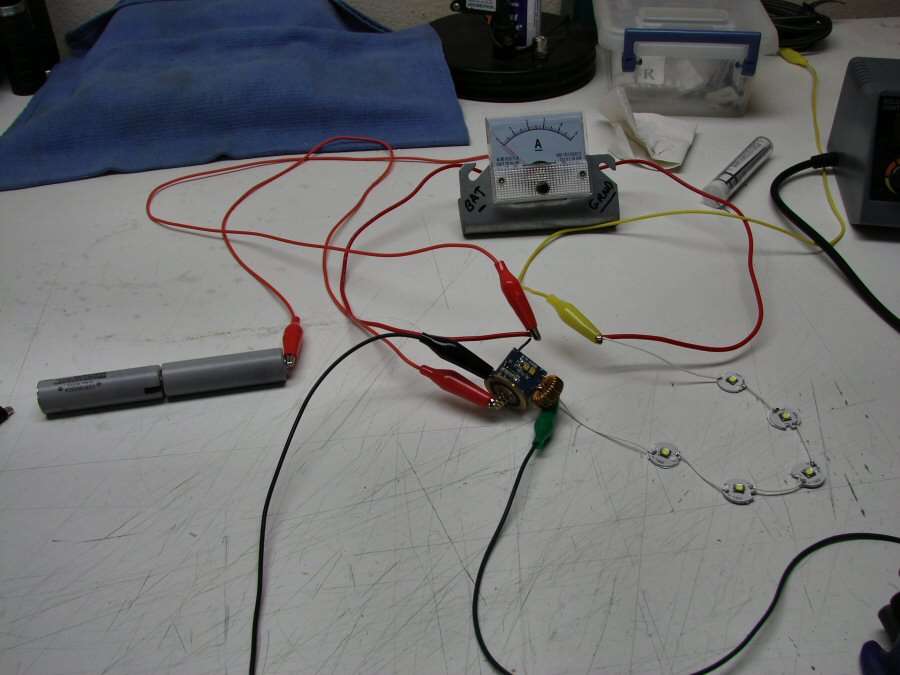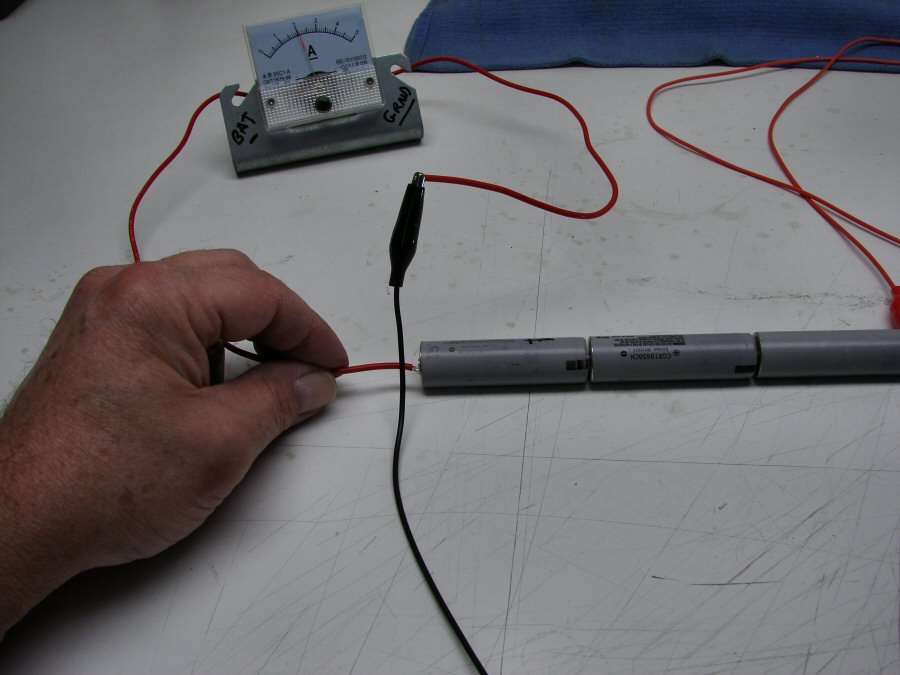another idea is put 3 or 4 R200 resistors in series in a piece of strip board and solder tiny wires from it.
So I set up my back woods Test Facility, to test out the driver input and output. As is, before any changes.

Set up to check amp draw to the leds

and Amp draw to the driver.
With Two 18650 batteries:
3.75 Amps going to the Driver on High
1.5 Amps to the leds on High
With Three 18650 batteries:
2 Amps going to the Driver on High
1.5 Amps to the leds on High
UPDATE: Driver Mod finished
I added the .68 ohm resistor and I got an increase from 1.5 amps to the leds, to 2.2 amps to the leds.
Then I did the .82 resistors (house style) and now I get 2.5 amps to the leds.
I think that's good enough. After all, it's just an Xmas giveaway light.
That is an electrical junction box cover. I love to use things for other than what they were intended.
I find that commodity items are cheap and sometimes offer a cheap and convenient solution to construction projects.
I would have to wonder how much added resistance all that wiring adds to your circuit. You may not be getting an accurate picture of what the draw would really be. If you are only interested in a before and after comparison then maybe it wouldn’t matter so much.
You could remove one of the R820's and remeasure to see how much current changed.
think if batteries at 3.7v load voltage,
with 3 batteries = 3.7v x 3 x 2A = 22.2W
with 2 batteries = 3.7v x 2 x 3.75A = 27.75W
that mean higher the input voltage, higher efficiency.
Now LED current confirmed 1.5A so
voltage drop in sense resistors 0.34 ohm x 1.5A = 0.51v
on this bench test, you can solder regular resistors and check LED current improvement.
for 2.5A you need 0.51 ohm, for 3A its 0.33 ohms.
2A - 2.5A more practical than 3A.
I would not bank on 1.5 amps to the emitter. Dchomak had a good point about all the wire and connections in the rig pictured above. It's quite possible that the driver will deliver the rated 2 amps in the light. Especially with O-L's skill at lowering resistance in a light.
EDIT: Added "not" above.
Wiring resistance can’t affect LED drive current because this is a boost driver. in here, boost convertor regulated to constant current. not voltage.
here simple test to prove that:
Add 0.5-1 ohm resistor series with LEDs
then check drive current again
Didn't realize that. Thank you for that info. In Post 26 above, don't you mean he needs about .2 ohms overall resistance to get 2.5 amps and .17 ohms for 3 amps? Resistance is already at .34 ohms.
yes he need overall resistance of 0.2 for 2.5A.
exiting resistance is 0.34 so we need 0.51 additional resistor to make 0.2 ohm overall.
So the resistors I just bought are no good… Well what happens if I use the 0.68 anyhow? I ordered .68 and .85 I believe. I can order others, but if I can mix and match from what is there…
As far as the amps from the driver to the leds, "all that wire" hooked to the amp meter is 14 gauge and with the length it is, the resistance would be minimal. The meter is hooked straight off the driver lead, then to the leds, so it reads right out of the driver. It probably is off from the batteries, but I bet it's not enough to be concerned about in this test. What matters to me is the 1.5 amp output to the leds with both 2 and 3 battery configurations. My concern is if the driver will take 3 amps. That's doubling up on the components there and I would hate to fry it.
Some of the leads shown were also just being used for the clips, to hold wires together, so they aren't in the circuit as such, just the clips, (which probably cause more resistance than the wires ).
).
you can use 0.68 ohm resistor instead of 0.51 for first try
then you can use 0.68 parallel with two series 0.85 resistors to get around 0.5 ohm.
so you don’t need to order other resistors again.
That’s right, a true current source is going to deliver the current, no matter what.
Working on a J12, and the KD driver is dead (D-E-D, dead). Dunno if I killed it or it was DOA, but maybe this eve or tomorrow eve I can do some of the same resistor experimenting. I already upgraded the light to XM-L2 U2 1A's/Noctigons. Been following this carefully and I have stock on a variety of resistors of 0805 and 1206 sizes (smaller ones from FT, bigger ones from DigiKey).
Edit: pretty sure I have a .5 (R500) 1206, so should try that first. If this works, I could send you one, OL, since I got a batch of each size that I ordered (like 10-20 or something, forget). I just randomly chose a few different sizes, think it cost $20-$30 or so all together w/shipping.
What is the bottleneck on these boost drivers? Why do they all seem restricted to sub 3 amp territory?
What is the bottleneck on these boost drivers? Why do they all seem restricted to sub 3 amp territory?
I think its input power limitation. specially with low input voltage. 2-4 series li-ion.
low input voltage -> high input current & low efficiency.
so these drivers need very low RDS.on FETs & high current low resistance inductors
Added a 1206 0.5 ohm resistor (R500), and it's working so far! So far, so good. tailcap amps is 3.95A with 3 TF 5000's, bout double stock (1.95A). I plopped the resistor down in the empty slot shown in the OP pic. So, with 5 XM-L2 U2 1A's on Noctigons, AS5 under the stars, polished pill top, 24 gauge wires between LED's, 22 gauge to the driver. I measured 4,500 lumens @start, 4,420 lumens @30 secs. Very clearly brighter than my stock J18.
Still need to copper braid both springs to keep them from melting. Really need to put an AR lens in there too, since the HD2010 size fits perfect...
All 5 modes seem to work fine. Tried 2 cells briefly, didn't measure tailcap amps, but light box read a little lower and seemed to be dropping fast. I'll have to revisit that, but after I do the copper braiding . 
pm me if you want an R500 - got a bunch from Digikey, can get one in a letter, mailed to you tomorrow if you want.
Ok, I got some resistors today.
R68 and R82 - they are 1/4 watt
R680 and R820 - They are 1/2 watt
All are the same dimensions and all are 1%. I would think I should use the 1/2 watt. Correct?